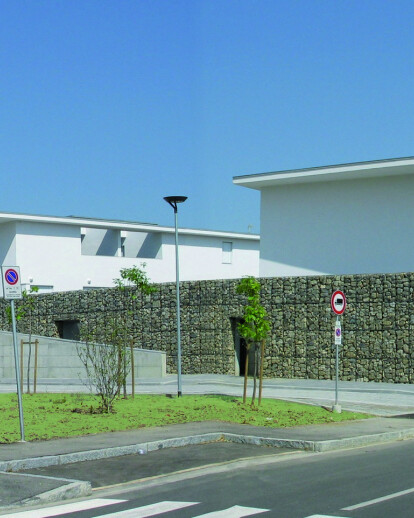The design of the settlement layout is based on the recognition of landform. The project re-proposes latent settlement rules, yet consolidated, able to recover the structuring capacity of the layout and its landscape value.
Six buildings of 60 m long are arranged in the lot according to a north-south orientation with slightly changes in direction. A wall of dry stone delimits the project on the west side and marks the boundary between the industrial area and the new residential compound on the edge of the Tavola old village.
The massive wall has the function to reduce the hydrologic risk due to the vicinity of a riverbank and to the alluvial origin of the terrain. The wall brings unity to the new residential development formed by several construction phases, different clients and users.
The wall structure is built with metal gabions filled with local limestone loose rocks. This technique refers to the local building tradition of dry stone walls. The technology of gabions, currently used for hydraulic interventions, has the characteristics of mass, strength and thickness of a dry stone wall and has a limited impact on the intervention’s budget. It evokes a water bank and refers to the origin of the site alluvial plain. Overall, the stone wall recalls the relationship between the buildings of the historic center of Prato and the ancient walls that surround it.
The project responds to the complexity of the program and avoids the monotony of a single large-scale intervention through the generation of a wide variety of public spaces, reminiscent in scale of the walkways of the historic fabric.
At the first floor level an elevated walkway above the wall connects the open galleries that give access to the dwellings entrance doors. From this walkway it is possible to overlook the surrounding hills and landscape and stop in one of the sight-seeing terraces.
An interior pedestrian promenade crosses the plot lengthwise and is characterized by a sequence of small public spaces designed as gathering spaces, children playgrounds, bicycle parking, etc. The promenade connects the different building blocks providing an access from the public road on the north to the interior of the residential compound to the south. A shared garden is located between the two building blocks to the north and along the main road parallel to the dry stone wall.
The public space is designed in order to provide to everyone the same opportunity of space fruition allowing disabled people to move freely without need of technological means.
The row house with private garden, typical of the Tuscan tradition, has been reinterpreted with the aim of providing each unit with a private outdoor space and a small kitchen garden. This solution optimizes the need of open public spaces maintenance and, at the same time, promotes food self-production.
The building blocks present two different facades: the first has a public character where a gallery gives accesses to each dwelling and overlooks the access road to the ground floor; the second, more domestic, is open over the private gardens. The distribution galleries on the first floor are accessible directly from the dry stone wall through ramps and stairs, as well as by staircases on the top and center of the buildings.
The buildings blocks are simple white plastered volumes on two levels suspended on a basement of concrete facing walls that delimit the private spaces on the ground floor.





























